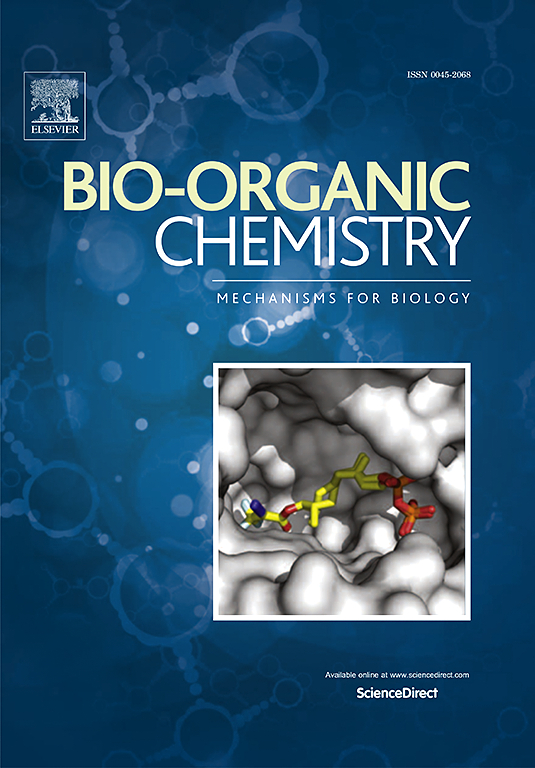设计和合成新型2- s -烷基化喹唑啉酮作为黑色素瘤中BRAFV600E和EGFR双重抑制剂:凋亡和细胞周期调节的机制见解
IF 4.5
2区 医学
Q1 BIOCHEMISTRY & MOLECULAR BIOLOGY
引用次数: 0
摘要
黑色素瘤是一种侵袭性和高度转移性的皮肤癌,由于其对传统疗法的耐药性和BRAF信号通路的频繁突变,治疗仍然具有挑战性。在这项研究中,我们设计和合成了一系列新的13种喹唑啉酮衍生物,其特征是苯基噻唑部分通过三唑乙酰胺间隔剂连接。这些化合物被开发为BRAFV600E和EGFR的潜在双重抑制剂,应该为黑色素瘤治疗提供一个有希望的治疗策略。这些化合物的抗增殖活性在NCI-60细胞系面板上进行了评估,其中六种化合物进入了五剂量筛选。化合物7k、7l和7m表现出广谱的抗癌活性,平均生长抑制率(GI%)超过100%。化合物7l对黑色素瘤亚型(GI% = 152%)表现出卓越的疗效,对B-RAFV600E的IC50值为0.048 μM,对EGFR的IC50值为0.037 μM。体外研究表明,化合物7l对malme - 3m (IC50 = 3.16 μM)和LOX-IMVI (IC50 = 2.50 μM)黑色素瘤细胞系具有显著的细胞毒性,对正常Vero细胞的毒性最小。细胞周期分析显示黑色素瘤细胞g1期阻滞和DNA合成中断,而凋亡分析显示早期凋亡细胞从7.28%急剧增加到40.69%。化合物7l调节关键凋亡标志物,使BAX/Bcl-2比值提高14.42倍,caspase 3和9水平升高,表明其在黑色素瘤治疗中具有克服耐药和提高疗效的潜力。本文章由计算机程序翻译,如有差异,请以英文原文为准。

Design and synthesis of novel 2-S-alkylated Quinazolinones as dual BRAFV600E and EGFR inhibitors in melanoma: Mechanistic insights from apoptosis and cell cycle modulation
Melanoma, an aggressive and highly metastatic form of skin cancer, remains challenging to treat due to its resistance to conventional therapies and frequent mutations in the BRAF signaling pathway. In this study, we report the design and synthesis of a novel series of thirteen quinazolinone derivatives, featuring a phenyl thiazole moiety linked via a triazole acetamide spacer. These compounds were developed as potential dual inhibitors of BRAFV600E and EGFR, which should offer a promising therapeutic strategy for melanoma treatment. The antiproliferative activity of these compounds was evaluated against the NCI-60 cell line panel, with six compounds advancing to a five-dose screening. Three compounds, 7k, 7l, and 7m, exhibited broad-spectrum anticancer activity, with mean growth inhibition (GI%) exceeding 100 %. Compound 7l demonstrated exceptional efficacy against melanoma subpanels (GI% = 152 %) and potent dual kinase inhibition, with IC50 values of 0.048 μM against B-RAFV600E and 0.037 μM against EGFR. In vitro studies of compound 7l revealed significant cytotoxicity against MALME-3 M (IC50 = 3.16 μM) and LOX-IMVI (IC50 = 2.50 μM) melanoma cell lines, with minimal toxicity towards normal Vero cells. Cell cycle analysis showed G1-phase arrest and disrupted DNA synthesis in melanoma cells, while apoptosis assays demonstrated a dramatic increase in early apoptotic cells from 7.28 % to 40.69 %. Compound 7l modulated key apoptotic markers, increasing the BAX/Bcl-2 ratio by 14.42-fold and elevating caspase 3 and 9 levels, indicating its potential to overcome drug resistance and enhance therapeutic efficacy in melanoma treatment.
求助全文
通过发布文献求助,成功后即可免费获取论文全文。
去求助
来源期刊

Bioorganic Chemistry
生物-生化与分子生物学
CiteScore
9.70
自引率
3.90%
发文量
679
审稿时长
31 days
期刊介绍:
Bioorganic Chemistry publishes research that addresses biological questions at the molecular level, using organic chemistry and principles of physical organic chemistry. The scope of the journal covers a range of topics at the organic chemistry-biology interface, including: enzyme catalysis, biotransformation and enzyme inhibition; nucleic acids chemistry; medicinal chemistry; natural product chemistry, natural product synthesis and natural product biosynthesis; antimicrobial agents; lipid and peptide chemistry; biophysical chemistry; biological probes; bio-orthogonal chemistry and biomimetic chemistry.
For manuscripts dealing with synthetic bioactive compounds, the Journal requires that the molecular target of the compounds described must be known, and must be demonstrated experimentally in the manuscript. For studies involving natural products, if the molecular target is unknown, some data beyond simple cell-based toxicity studies to provide insight into the mechanism of action is required. Studies supported by molecular docking are welcome, but must be supported by experimental data. The Journal does not consider manuscripts that are purely theoretical or computational in nature.
The Journal publishes regular articles, short communications and reviews. Reviews are normally invited by Editors or Editorial Board members. Authors of unsolicited reviews should first contact an Editor or Editorial Board member to determine whether the proposed article is within the scope of the Journal.
 求助内容:
求助内容: 应助结果提醒方式:
应助结果提醒方式:


